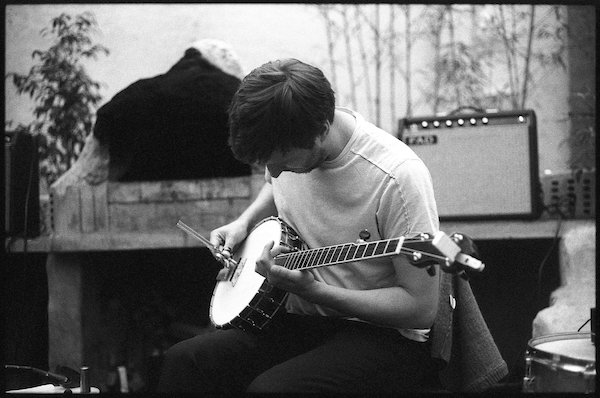Jun 3, 2025 11:25 AM
In Memoriam: Al Foster, 1943–2025
Al Foster, a drummer regarded for his fluency across the bebop, post-bop and funk/fusion lineages of jazz, died May 28…

Guitarist Ruben Machtelinckx formed the Aspen Edities imprint in 2017 alongside euphonium player Niels Van Heertum and writer Sanne Huysmans
(Photo: Mark Rietveld)Last winter, at the Brand Festival in the quaint Belgian city of Mechelen, guitarist and improviser Ruben Machtelinckx and three close collaborators performed in near darkness, conjuring a gauzy lattice of sound imbued by fragile, haunting melodies. Some of the all-acoustic pieces—played by Machtelinckx, fellow guitarist Bert Cools, reedist Joachim Badenhorst and percussionist Toma Gouband—were composed by the leader; others were improvised on the spot. Iin both cases, the quartet summoned an elusive world of sound that drew upon the ineluctable unpredictability of nature.
The music was a long way from what Machtelinckx, now 34, was making just six or seven years ago, when he was forging a beautifully pastoral strain of modern jazz, often with the same collaborators.
“It wouldn’t feel fresh to play the same things I did eight years ago,” he said. “In the general music landscape, it maybe feels a bit dated for me, what I was doing.”
Indeed, what he’s doing now has a certain out-of-time quality. As heard on the same quartet’s 2012 debut, Porous Structures (Aspen Edities), the music is both sui generis and warmly familiar to listeners with the patience to notice the small rustling sounds and gentle sonic interactions that fill everyday life.
“We’re trying to achieve a state of being. It doesn’t have to go anywhere or have a direction,” Machtelinckx said. “Someone told me that the music felt accidental in a way, and I took it as a compliment, because that’s kind of what we want to achieve.”
Machtelinckx, who grew up in the tiny village of Rozebeke, picked up the guitar when he was 15, inspired by rock music. But by the time he enrolled at Royal Conservatory Antwerp, he’d immersed himself in jazz and found several important collaborators who continue working with him more than a decade later: reedist Thomas Jillings and bassist Nathan Wouters. After finishing his studies in 2010, Machtelinckx often traveled to Copenhagen, where he took lessons with guitarist Jakob Bro, and met and began to play with Badenhorst and the Icelandic guitarist Hilmar Jensson. He formed a quartet with the latter two and Wouters, releasing two albums of ruminative post-bop balladry with a distinctly Scandinavian tint.
Over time, however, Machtelinckx began exploring music less reliant on harmonic rules and conventional structures, a shift that aligned with his forming Aspen Edities in 2017 alongside euphonium player Niels Van Heertum and writer Sanne Huysmans. The imprint’s first release, Mono No Aware, featured Linus, the guitarist’s project with reedist Jillings, which regularly had worked with a variety of collaborators, including Hardanger fiddle master Nils Økland. In the years since, the label has documented his growth, whether through Poor Isa, Machtelinckx’s experimental banjo duo with Frederik Leroux, or Veder, a moody quartet with Van Heertum, Badenhorst and trumpeter Eivind Lønning that still retains vestiges of a post-ECM jazz aesthetic.
Yet, the music on Porous Structures seems like the most relevant exposition on his current interests. After experiencing Gouband’s playing—where he rubs and strikes stones together, using his kit mostly as a resonator and opting for tree branches rather than sticks or brushes—Machtelinckx said, “The idea of the pitch of the stones and the harmonics of the guitar formed a really nice blend, and I imagined a second acoustic guitar—the sound came together in my head really quickly. Joachim has the freest role.”
A few years ago, the guitarist moved back to the countryside, settling in Roborst, a village located about an hour from Brussels. “There are less things happening, less distractions,” he said.
The quietude and purity of that environment has worked its way into the music—as well as the label, which has released work by like-minded artists, including multi-instrumentalist Shahzad Ismaily and the Finnish early-music singer Aino Peltomaa.
“Running the label is more difficult than I thought it would be, even releasing small editions of 200 copies,” Machtelinckx said. “But I still love it and I love graphic arts, and it’s a great way to work with artists and give them the opportunity of the format of the album to make something.” DB
This story originally was published in the August 2020 issue of DownBeat. Subscribe here.

Foster was truly a drummer to the stars, including Miles Davis, Sonny Rollins and Joe Henderson.
Jun 3, 2025 11:25 AM
Al Foster, a drummer regarded for his fluency across the bebop, post-bop and funk/fusion lineages of jazz, died May 28…

“Branford’s playing has steadily improved,” says younger brother Wynton Marsalis. “He’s just gotten more and more serious.”
May 20, 2025 11:58 AM
Branford Marsalis was on the road again. Coffee cup in hand, the saxophonist — sporting a gray hoodie and a look of…

“What did I want more of when I was this age?” Sasha Berliner asks when she’s in her teaching mode.
May 13, 2025 12:39 PM
Part of the jazz vibraphone conversation since her late teens, Sasha Berliner has long come across as a fully formed…

Roscoe Mitchell will receive a Lifetime Achievement award at this year’s Vision Festival.
May 27, 2025 6:21 PM
Arts for Art has announced the full lineup for the 2025 Vision Festival, which will run June 2–7 at Roulette…

Benny Benack III and his quartet took the Midwest Jazz Collective’s route for a test run this spring.
Jun 3, 2025 10:31 AM
The time and labor required to tour is, for many musicians, daunting at best and prohibitive at worst. It’s hardly…